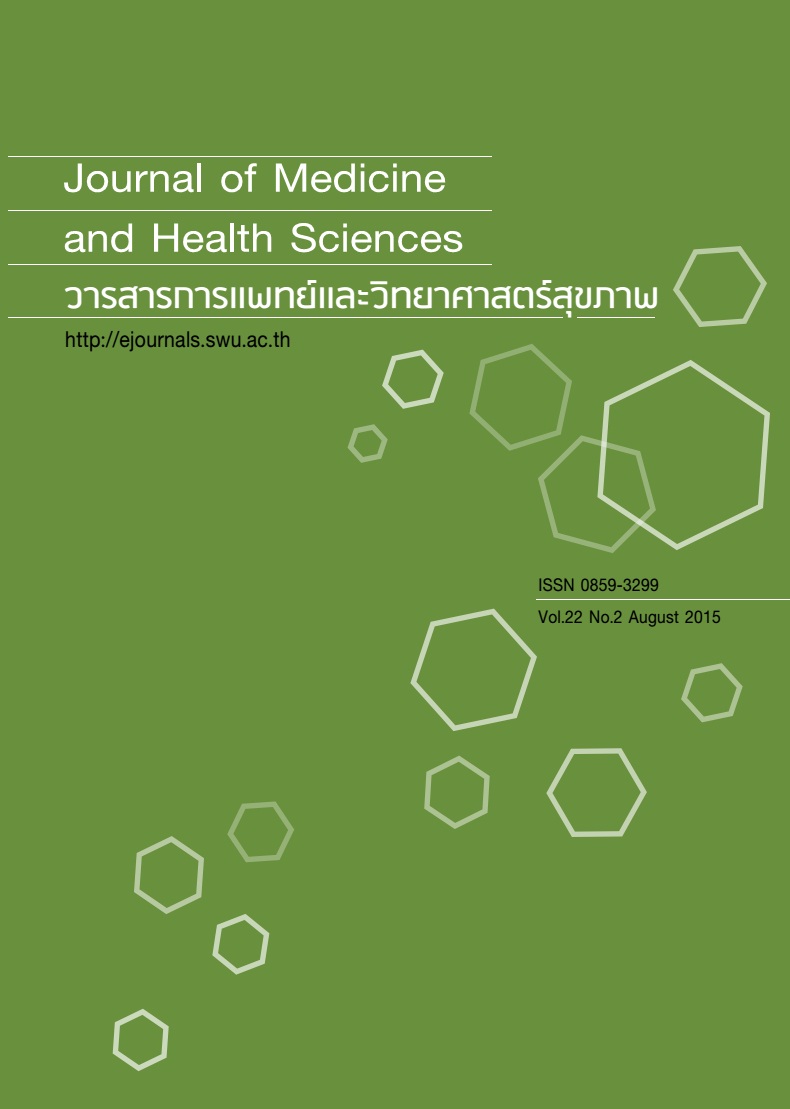Evaluation of pathogenic microorganisms contaminated in dermatology outpatient clinic during the midst of rainy season
Keywords:
เชื้อจุลชีพก่อโรค, คลินิกผิวหนัง, ฤดูฝน, pathogenic microorganism, dermatology outpatient clinic, rainy seasonAbstract
The pathogenic microorganism can be rapidly grown in condition of high humidity, which was a common condition in rainy season and led to cause of diseases especially in immune-compromised patients. Due to most of the patients visited the clinic presented with skin infection caused from pathogenic microorganisms, the scratch and pick out of the scaly residue were always the common patients manner that can spread out of contamination in the clinic. This study aimed to evaluate the contamination of pathogenic microorganisms in dermatology outpatient clinic during the rainy season. Samples were collected from 7 rooms in the dermatology clinic in which 15 spot sampling sites each by using spot test technique and collected 3 times a day (3 hours before clinic opened, 3 hours after clinic opened, and 3 hours after clinic closed). The sample was cultured and determined. The results found that 85% were positive and could be identified as 15% of gram-positive bacteria, 6% of gram-negative bacteria, 24% of yeast, and 55% of mold. This study provided promising information to prevent pathogenic contamination in dermatology outpatient clinic. Hygienic practical routine (effective methods and suitable chemical agents) needs to be encouraged in the clinic in order to decrease the contamination. Moreover, the statistical data of new pathogenic infection in patients should be monitored and compared with other similar dermatology outpatient clinics, which will help to improve human health and minimal the risk of contamination effects.
การตรวจหาการปนเปื้อนของเชื้อจุลชีพ ก่อโรคในคลินิกผิวหนังในฤดูฝน
ในสภาวะที่มีความชื้นสูง เชื้อจุลชีพก่อโรคบางชนิดสามารถเจริญเติบโตได้ดีและสามารถก่อโรคได้โดยเฉพาะกับผู้ที่ มีความบกพร่องทางระบบภูมิคุ้มกัน ซึ่งสภาวะความชื้นสูงมักจะเกิดในฤดูฝน โดยการศึกษาในครั้งนี้มีวัตถุประสงค์เพื่อศึกษา การปนเปื้อนของเชื้อจุลชีพก่อโรคในคลินิกผิวหนังช่วงฤดูฝนเนื่องจากผู้มารับบริการคลินิกผิวหนังส่วนใหญ่มักมาด้วยการ ติดเชื้อจุลชีพบริเวณผิวหนังและอาจมีการแคะ แกะ เกา ซึ่งอาจนำไปสู่การปนเปื้อนเชื้อจุลชีพก่อโรคในคลินิกผิวหนัง โดยได้ ทำการศึกษาด้วยการสุ่มเก็บตัวอย่างโดยวิธีSpot test จากคลินิกผิวหนังจำนวน 7 ห้อง ห้องละ 15 จุด ทำการเก็บตัวอย่าง 3 เวลา คือ 3 ชั่วโมงก่อนเปิดบริการ 3 ชั่งโมงหลังการเปิดบริการ และ 3 ชั่วโมงหลังจากคลินิกปิดบริการ จากนั้นนำตัวอย่าง มาเพาะเลี้ยงเชื้อ และแยกชนิดของเชื้อจุลชีพ โดยทำสัปดาห์ละ 3 วัน ติดต่อกัน 6 สัปดาห์ผลการศึกษาพบว่าจากตัวอย่าง เชื้อมีการปนเปื้อนของเชื้อจุลชีพก่อโรคถึงร้อยละ 85 ซึ่งสามารถแยกได้เป็นเชื้อแบคทีเรียแกรมบวกร้อยละ 15 แบคทีเรีย แกรมลบร้อยละ 6 ส่าร้อยละ 24 และราสายร้อยละ 55 ซึ่งจากผลการศึกษาการปนเปื้อนของเชื้อจุลชีพในคลินิกผิวหนัง ในครั้งนี้นำไปสู่การป้องกันที่ดีกล่าวคือการทำความสะอาดเพื่อการลดการปนเปื้อนของจุลชีพก่อโรคและลดอัตราการเกิด การติดเชื้อจุลชีพเพิ่มในผู้รับบริการ ควรคำนึงถึงความถี่ และสารเคมีที่ใช้ในการทำความสะอาด อีกทั้งผลการศึกษาที่ได้จาก การศึกษาในครั้งนี้สามารถนำไปพัฒนาศึกษาต่อยอดเกี่ยวกับอัตราการเพิ่มขึ้นของการติดเชื้อจุลชีพก่อโรคเปรียบเทียบการ ปนเปื้อนของเชื้อจุลชีพก่อโรคในฤดูฝนกับฤดูกาลอื่นและในคลินิกอื่นๆ ต่อไป



